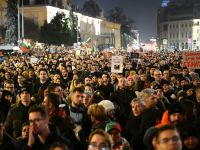Jbeil’s Modern and Contemporary Art Museum has gathered artists from over 20 nationalities to tackle a global topic: data.
MACAM recently launched its second Biennale of Contemporary Art under the theme “Universal Data,” seeking to create a conversation about something that has become an almost inseparable part of our daily lives.
Behind the massive metal gate of the industrial hanger that the museum calls home, 60 local and international artists are showcasing multidisciplinary artworks that explore our use of and interaction with the unrelentingly digitalized universe.
“We’re all so connected with our phones and online and it’s only increasing,” curator Sara Schaub said. “We’re really in the midst of this digital age where consumers produce so much data, but do we actually know how much, where it goes and what’s happening? This exhibition is an incentive to think about it a bit more, in all its facets.”
Through installations, paintings, sculptures, videos, and live and digital performances, artists address a range of topics, including access to information, digital identity, freedom of expression, online communities and more.
“Rina Jaber was working on how the data world is intangible and immaterial so we can’t really visualize it,” Schaub said, referring to the Lebanese artist’s sculpture “Data Access for Future Millennia.”
“This work reflects on what remains of us in years to come, because nothing is tangible, and she used these clay tablets from ancient times and coded them with binary code and html for our future generations,” Schaub added.
{"preview_thumbnail":"https://cdn.flowplayer.com/6684a05f-6468-4ecd-87d5-a748773282a3/i/v-i-8…","video_id":"8bc81711-d950-4c13-9d5d-075456a9e4d3","player_id":"8ca46225-42a2-4245-9c20-7850ae937431","provider":"flowplayer","video":"Many Dead and Injured after Anti Government Rallies Protesting in Iraq"}
Spanish artist Xavi Munoz’s “Babel - Tower to Heaven” also re-frames an ancient narrative from a modern angle, creating an installation of 400 glass jars that are meant to represent a well-known piece of biblical architecture.
“He was inspired by the story of Babel and decided to take many pictures of the sky, take these glass jars and make a scaled representation of how the tower was meant to look,” Schaub said. “The story tells of the time when the world’s languages where created, so he used Google Translate to translate the word ‘sky’ into 103 languages, the number we can translate online nowadays.
“Through universal data we now have access to all these languages which a few years ago would have been much more difficult to translate,” she added. “In this new era we can easily communicate globally, through this linguistic digitization.”
Artworks addressing hacking, security leaks, the fragility and manipulation of data and equal access to data are also on show, taking a look at the more sinister, less useful side of data.
In commemoration of the 70th anniversary of the Declaration of Human Rights, Schaub asked the artists to reflect on how the 12 articles apply in the digital era and how access to data has influenced our perception of the world. One work, by Lebanon’s Nadine Zahreddine, displays broken number plates in the shape of Lebanon’s territory, with a camera watching over it all.
“Nadine Zahreddine talks about data privacy and the amount of data that’s collected through car number plates and street surveillance cameras,” Schaub said. “Everyone can access your data through the number plates - is it right, is it fair? - It’s related to why in Lebanon they’re now updating the number plates.
“From that number they can get your identity, location, track your movement, where you go, what you do,” she added. “Many of the artists looked at this human rights and right to privacy angle.”
This article has been adapted from its original source.








